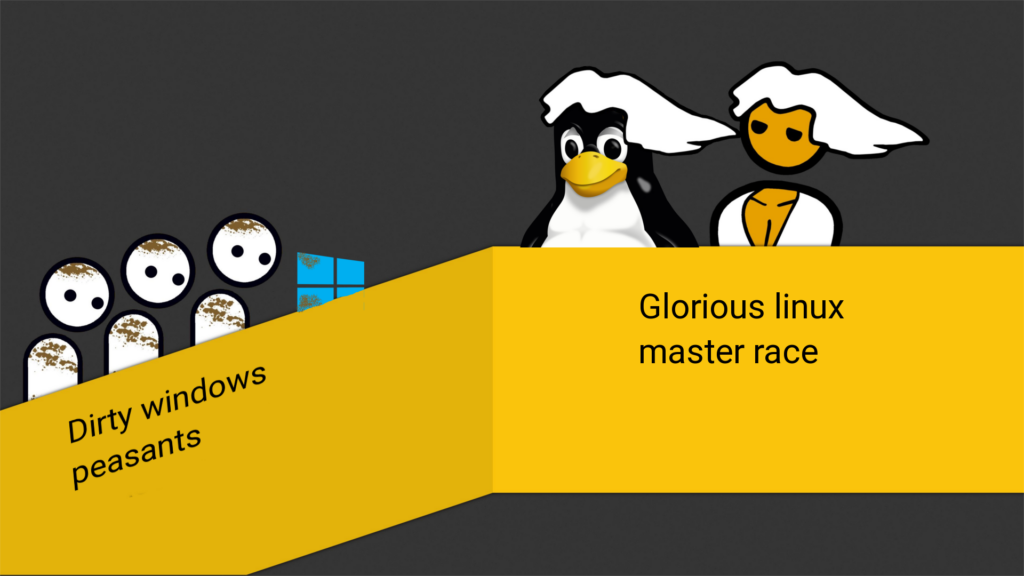The many little things that really stop GNU/Linux from becoming a widespread Desktop solution
For years now, Linux is struggling to really achieve a stable foothold in the world of desktop computers. Even though it’s the de-facto standard almost anywhere else, let it be Servers, Smartphones, IoT (Internet of Things), integrated systems and more, it just keeps failing to attract a greater userbase and is still most well known as a system for professionals and nerds, something you can’t actually get any other work done than what IT specialists do.
While this may change rapidly in the near future (mostly thanks to Valve, who’re pushing things with their Proton compatibility Layer and their soon-to-be-released Steam Deck that’s based on Arch Linux + KDE), the details that’re hitting on the breaks still persist and should, in my humble opinion, be put more into focus as the opportunity of a massive influx of new people is on the horizon.
Terminal-Affinity is hurting the experience
“As a user of [Linux & Win] now – Aaaaay… – they’re both bad.”
Linus Sebastian, CEO Linus Media Group
Just by reading this, many users may be instantly outraged. The Terminal is one of the reasons Linux is so beloved by many professionals, and it’s obvious why: Unlike Windows, it gives you access to absolutely everything. Why should anyone despise it?
The reason is quite simple: Accessibility. Let me give you an example.

Recently, Linus Sebastian from the well beloved Linus Tech Tips Youtube Channel has started a “Linux Challenge” with Luke, one of his colleagues. Both are seasoned Windows powerusers who now switch to Linux for (at least?) a month while recording their experience. The videos are not out yet, but they’re already talking lengthly about it on their weekly WAN show. And while they also struggle with problems that just pop up as people use vastly different configurations with devices from manufacturers that may or may not respect some standards as they should, they also encounter problems that are so incredibly unnecessary you wonder why there’s still only a commandline option for that.
As an example he brings up a file copy into a folder that belongs to root. Things like this should not be a big deal, especially not on an operating system that keeps being praised as being most open and letting the user do whatever they want to do (even if it’s unfathomably stupid). Yet, even after 20 years, big Linux file managers like Nautilus and Dolphin still do not have implemented a proper system to raise privileges on users demand, making it virtually impossible to administrate your own computer outside of the terminal. This is especially frustrating as tutorials for Linux are praised to be super simple because of their copy & paste nature, yet as soon as you have to copy a file to a destination outside of your /home folder you have to learn how sudo ‘cp -r <src> <dest>‘ means, directly followed by chown as well as chmod to set up file permissions correctly. Not to mention cd and ls if you never saw a terminal before. Welcome to Linux.
This is just one example, but it leads to one of the biggest issues as the file privilege system of Linux may be powerful, but to new users it’s a literal beast.
Such problems don’t come from nowhere. As the GNU/Linux Community is mainly made out of nerds and professionals, there aren’t enough people to demand a solution thats not just easy to use if you already know it, but also intuitive on first glance and a great experience to use (which, for most people includes a GUI). Even something small like asking if you want to either open or execute the file you just double-clicked makes a huge difference for someone who’s trying to find his way through something new they don’t have to use. Telling a frustrated user to “use chmod +x” after their executable only opens as text file only leads to even more frustration. Not to mention file managers even implemented the “make file executable” checkbox, it’s just rarely mentioned.
A loud minority of Toxic Elitists
“Just go back to Windows if you don’t want to learn yourself.”
A toxic response

Of course, neither of the above applies to every distro (Linux Mint does these things really well for example), nor does the following apply to every forum or distro-specific community. Yet, every new Linux user will eventually face the dreaded dragon of the Linux Community: a toxic, elitist environment where your trouble will be met with ridicule, as only filthy non-Linux peasants would dare to expect a graphical experience over the chad command line. /s
Jokes aside, experiences like this are made daily and keep driving away potential newcomers. And even if you’re not the person who’s directly involved, looking up solutions only to find toxicity towards others who were right where you’re standing right now makes a lot of people wish their Windows back, where they knew how to go around. Keep in mind, nobody who tries Linux has to use it, but they want to use it. Being send back to where they came from, their bad experience with Linux will persist.

It can be even worse to be trapped in the pit between apologists of different distros while looking for help. Nobody is helped by reading “Oh, you should’ve picked my distro over your distro because that distro sucks”. From my personal experience, most of these people don’t even think about what’d be best for the one who asked, but what they like best. If you don’t support that you might as well go back to your dirty Windows. /s
This can lead up to ridiculous situations, in where you can get accused of being stupid simply because of your choice of distro. Those people can’t be helped, but given the size of the community, overlaps in distros and the almost absolute lack of graphical tutorials you’ll eventually meet those people. Even worse, they might argue that the missing feature protects you from harming your own system – an argument we constantly hear from Apple. Hard to be more disrespectful if you ask me.
Still worth the hassle
“User Experience? Very good. […] Which is why I’m genuinely switching my work laptop to Linux and I genuinely think it’s gonna be a better experience.”
Luke Lafreniere, COO Floatplane Media
Despite all the problems and the initial learning curve being a 90° brick wall as soon as you’re forced into the terminal, it can be very much worth the hassle. There are communities out there which are very welcoming too, Linux Mint communities being a good example. But if the Linux Community really wants to keep up the pace all the system options finally need to be made accessible graphically, details like gnome-tweaks not being present by default have to be ironed out (they’re working on that tho’) and a better documentation has to be present on how to get by solely by the means of the GUI to not just attract new users, but to keep them.
Because let’s be real, users that aren’t tech-savvy don’t want to use the terminal. They want a nice clicky button to press while not being treated like idiots.
